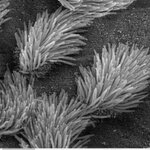Genetics & Molecular Biology

The reduced risk of cardiovascular disease seen in people who eat a Mediterranean diet may be attributable to the phenolic components of virgin olive oil, which repress several pro-inflammatory genes.
Phenols are micronutrients of olive oil; the extra-virgin varieties have a particularly large phenol fraction.
Researchers writing in the open access journal BMC Genomics studied the effects of eating a breakfast rich in phenol compounds on gene expression in 20 patients with metabolic syndrome, a common condition associated with increased risk of cardiovascular disease and type 2 diabetes.…

It is coming – so we might as well prepare for it psychologically. Researchers who manipulate DNA and RNA, and all of the incredible tools of creation that accompany them, have become so accomplished in the past 50 years that we are now facing realistic scenarios once relegated to alarmist science fiction.
I used to tell my high school Biology students ‘wild’ stories about the genetic research of the early 2000’s (so long ago!) I always felt as if I had to be extra animated because I was sure I sounded like a crackpot!
I would wave my arms and spit and spew while telling them about the…

Personalized genetics is hot in the news right now, but in fact we're generally terrible at using genotypes to predict who is going to get a disease. One villain here is the phenomenon known as epistasis, which essentially means that the physiological effect of one genetic variant depends on what other genetic variants (in other genes) are hanging around in the same genome.
Epistasis means that two siblings can inherit the same disease-causing genetic variant from their parents, and one child gets the disease while the other doesn't, because the second one has a second, somehow protective…
New tissue engineering research could greatly reduce the number of lab animals required for FDA mandated experimental trials on new health products with medical formulations.
Scientists from Tel Aviv University writing in Tissue Engineering say that the necessary tissue for animal trials can be produced from adult rat stem cells ― cells that can be stimulated to create skin, bone, fat and muscle tissue from an animal in a laboratory setting.
The use of engineered tissues may also be more scientifically efficient than using those from a living source. "The model we've created offers a very…

My academic adventures have exposed me to a fairly large amount of mathematics. While I seem to end up wishing I had taken even more mathematics, computer science, and statistics coursework every week or three, I've nevertheless been pretty grateful for having this sort of background as I've become involved with plant genomics research.
Interacting with the bioinformaticians in our lab has given me an appreciation for something that should have occurred to me long ago regarding the way biologists typically analyze microarray data. It seems like such a little thing, but its effects…

Scientists have developed a non-viral, synthetic nanoparticle carrier to improve and save the sight of mice with retinitis pigmentosa, an inherited disease characterized by progressive vision loss and eventual blindness, for which there is no cure.
The researchers say the findings are based on "a clinically relevant treatment paradigm" and may one day lead to a gene replacement therapy for human retinal degeneration.
The research is detailed in The FASEB Journal.
Mice with with the retinal degeneration slow (Rds) gene, which causes retinitis pigmentosa, received one of three types of "…

Hemophilia is caused by a genetic defect that inhibits the body's ability to control blood clotting. The two forms of the disease — hemophilia A and B — are associated with the absence of proteins called factor VIII and factor IX, respectively.
The disease affects millions of people and is sometimes untreatable due to patients' immune systems rejecting the standard treatment--infusion with a protein that helps the blood to clot.
To help patients tolerate therapy, doctors try to exhaust patients' immune systems by administering the therapeutic protein intravenously at frequent intervals and…

Mark Ptashne, Oliver Hobert, and Eric Davidson talk sense on epigenomics:
We were astonished to see two sentences in your Editorial on the International Human Epigenome Consortium (Nature 463, 587; 2010) that seem to disregard principles of gene regulation and of evolutionary and developmental biology that have been established during the past 50 years.
You say: “By 2004, large-scale genome projects were already indicating that genome sequences, within and across species, were too similar to be able to explain the diversity of life. It was instead clear that epigenetics — those changes to…

I've heard a senior colleague say that there is nothing fundamental left to be discovered in biology. It's a nagging worry some people have, including myself. What's left, according to some (including one of molecular biology's founders Sydney Brenner), is to work out the details of particular systems, implied by already established paradigms - kind like chemistry.
Chemistry's done, in terms of fundamental principles. There obviously is a lot we still don't know in this field, but what we don't know isn't likely to be earth shattering. Is this true in biology as well? As far as I can tell,…
Protein phosphorylation, the process by which proteins are flipped from one activation state to another, is a crucial function for most living beings, since it controls nearly every cellular process, including metabolism and gene transcription.
Biologists have learned that interactions by kinases (enzymes that add a phosphate to a protein) are highly regulated. Each of the 428 human serine/threonine kinases interact only with certain substrate proteins, and they pick their "partners" unfailingly. But for the reverse reaction, called dephosphorylation (removing a phosphate from a protein),…